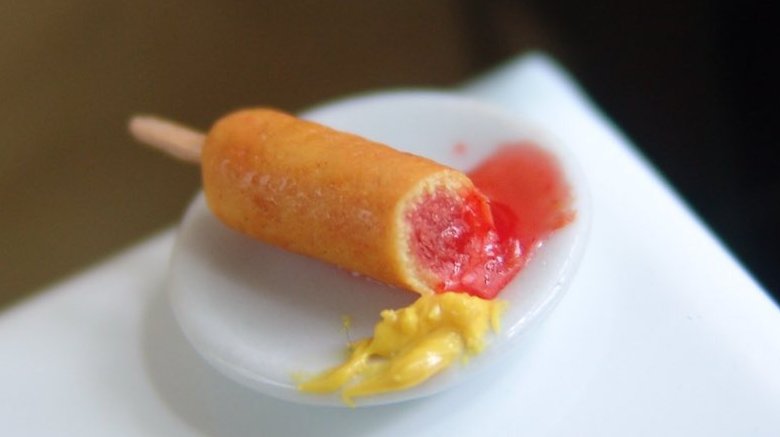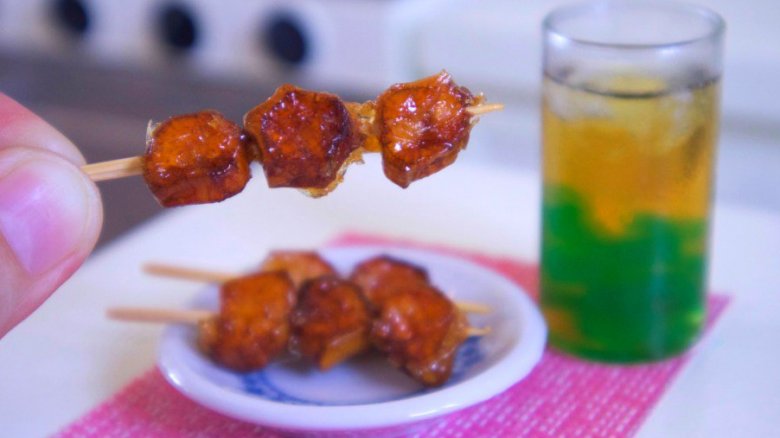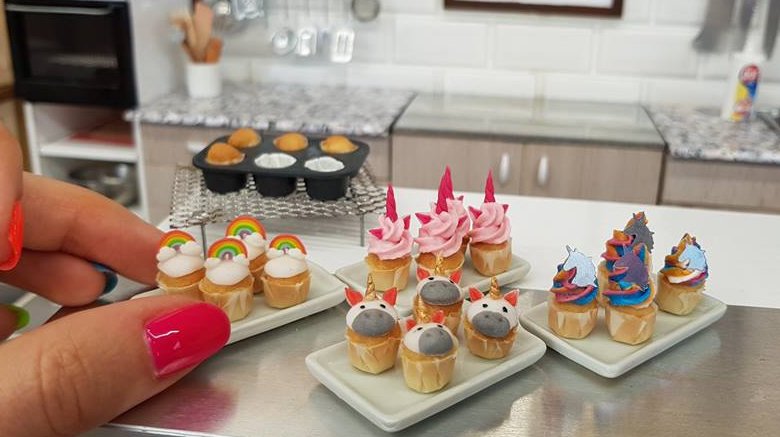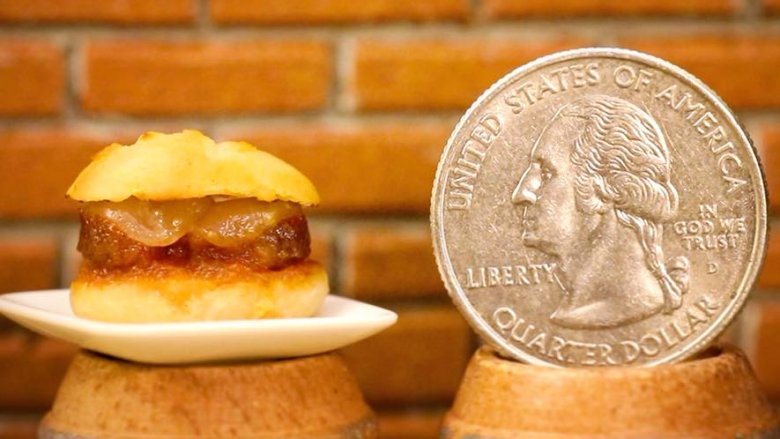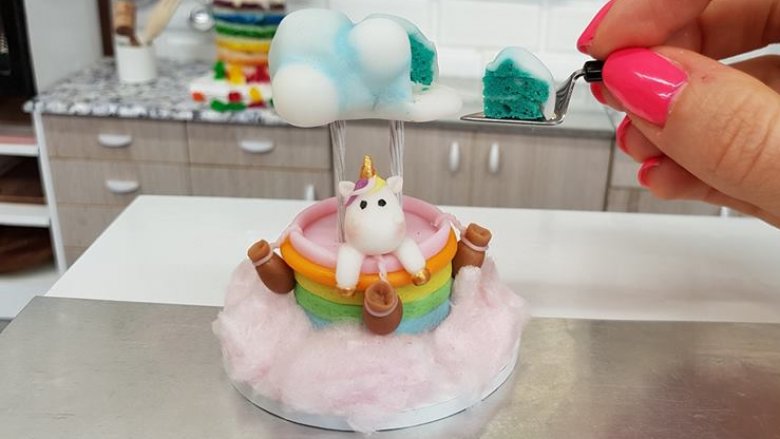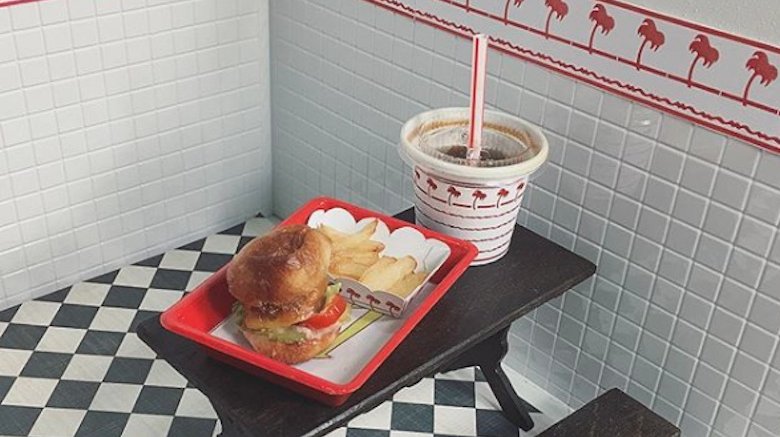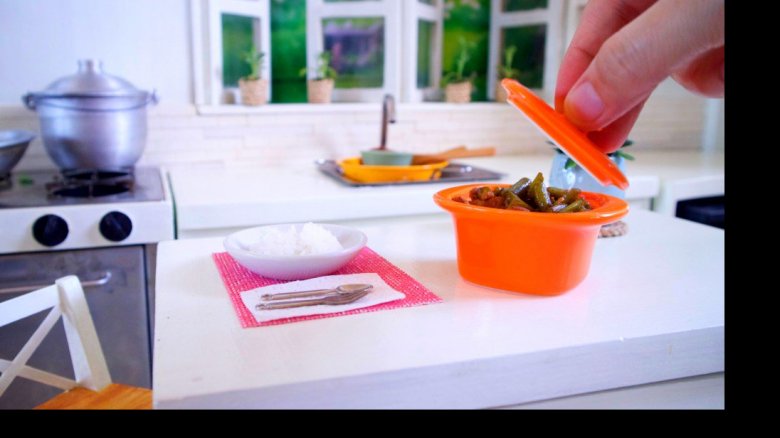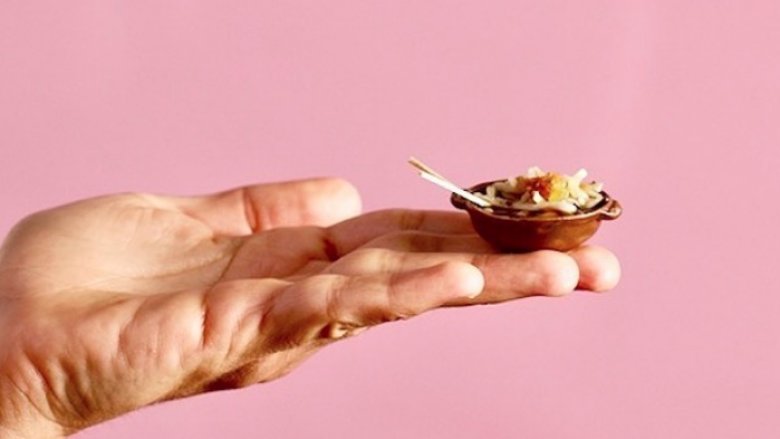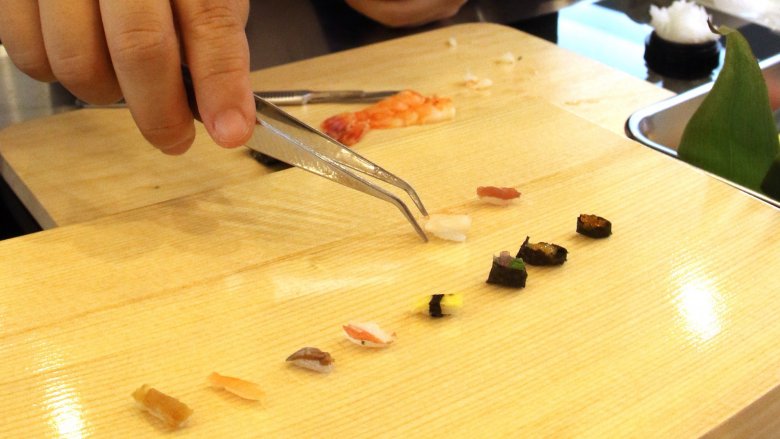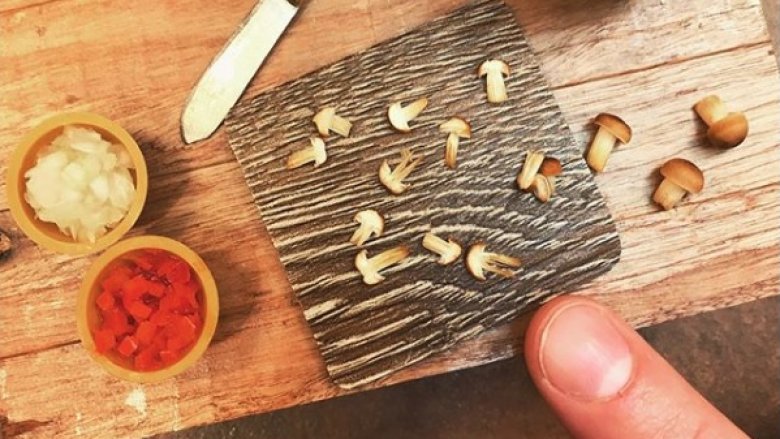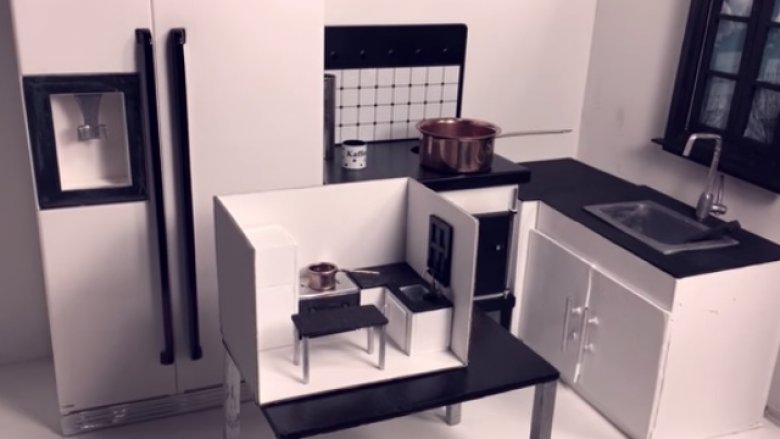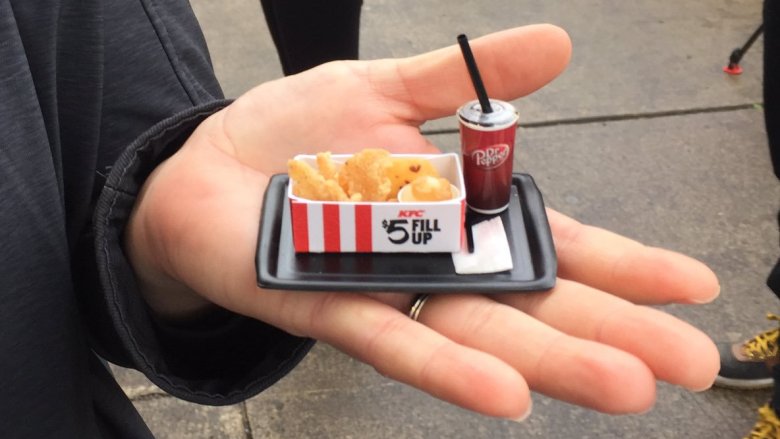The Untold Truth Of Tiny Food
American folklore is full of BIG things. As kids, we hear about the tale of the giant lumberjack Paul Bunyan and his big blue ox, Babe. Our roadsides are littered with "world's largest" roadside attractions from an apple in Virginia to a corn dog in Oregon. We love to marvel at the big and the bold here in the States, but lately there's been a trend that goes in the opposite direction: tiny food videos.
Tiny food videos feature people using scale sets — including furniture, accessories, and appliances straight out of "The Borrowers" — along with real food to create our favorite dishes, but in teeny-tiny, miniature sizes. These videos have become so popular, major publications including National Geographic and Vogue have weighed in on them. Now, there are more than 1.3 million results for "miniature food" on YouTube, as people all over the world have embraced the art form. Today, viewers can find videos making recipes ranging from simple miniature bacon and eggs to an entire tiny Thanksgiving dinner.
The food is real
A cursory search for "tiny food" in any search engine will show you tons of faux foods made by dollhouse enthusiasts and crafters. But there's nothing fake about these doll-sized foods. The tiny food videos we're talking about here use real ingredients to create these scrumptious miniature meals.
Sometimes, it simply takes less of the ingredient on hand to scale appropriately. For example, using only a few grains of rice allows you to create miniature tuna rolls. Other times, as with cooking eggs, making a miniature version takes a smaller substitution. For instance, tiny food artists often use quail eggs, which are about one-fifth of the size of the chicken eggs we normally find in our refrigerators. Whether or not the ingredients are prepared ahead of filming is up to the artist's discretion, but generally, there's a mix of both, just like in any life-sized cooking show.
That stove really works
Because these foods are made with real ingredients, many of them need heat to be edible. However, your grandmother's dollhouse stove wasn't made to actually cook anything. Instead, miniacs have to build their own tiny sets with functional stoves. Generally, they use a tea light as a source of heat.
Jennifer Ziemons of Jenny's Mini Cooking Show told Insider it took her six months to build her kitchen along with all the miniature tools she uses in her videos. And Jay Baron of the YouTube channel Walking with Giants told the publication that he handcrafts about 80% of his wares, utilizing everything from woodworking to glassblowing to reach that perfect aesthetic.
While some tiny food enthusiasts prefer to build everything from scratch, not all tiny enthusiasts have the skills to create this lifelike sets. Thankfully, artists like Shon Stoker of @MiniKitchenChef make real, working tiny kitchen stoves that are actually available for sale. As far as utensils like miniature knives, they can be found through artisans in Japan.
Cooking tiny foods is tricky
You may think that heating food up with a tea light would take hours, but in many cases the opposite is true. As Tiny Kitchen's Kate Murdoch told Mirror, because the quantities of food are so small, sometimes they can be done in seconds.
Murdoch says water "takes less than a minute to boil" and burgers "only need three or four seconds on either side." Of course, you can't really control the heat of a tea light, so it's important to be vigilant — a meal can be ruined if the artist takes their eyes off their tiny kitchen for even a moment.
What does take a long time is the preparation of each ingredient. While sometimes mini chefs use creative substitutions, like the quail egg swap, things like fruits and vegetables must be cut down to scale. Furthermore, it takes time for the artists to get used to working with such small portions. It's not easy to maneuver a rolling pin with a single finger or to flip a gyoza the size of your nail with the tips of chopsticks! According to Murdoch, it takes a lot of trial and error before a tiny chef can film their process without it looking super awkward.
The techniques used run the gamut
These videos have become so popular, you can find dishes from all over the world from simple scrambled eggs to a complex curry. The cooking techniques tiny chefs use are as varied as the dishes they make, and viewers who would otherwise never know how to make certain dishes are all of a sudden educated on what it actually takes to execute a recipe.
Not everything you will find is cooked on a tiny stovetop. Some of these artists go as far as making their own functional ovens for baking tiny cakes and cookies. Others hunt down miniature versions of common kitchen appliances like blenders to make smoothies, juices, and milkshakes. There are even tiny chefs who make their own itty-bitty grills for perfect BBQ chicken. And, of course, there's very little cooking involved at all when it comes to making tiny sushi.
It takes hours to produce one video
Just because these meals are small doesn't mean it takes a fraction of the time to produce these visual delights. In fact, when taking into account the hours spent handcrafting the tools, lighting the set, and filming all the right angles, it takes hours to create just one video cooking these tiny foods. According to Jay Baron, his YouTube videos that take "from eight hours to 50 hours" to make. Kate Murdoch says that filming a 90-second video "can take three hours, depending on the recipe." This estimates are just for the cooking and preparation — they don't even take into account the amount of time it takes to edit and publish a video.
Tiny food videos are not long. They can last anywhere from three to 20 minutes, but generally you'll find them in the five to 10 area. Yet as short as they are, making them is an incredibly time-consuming endeavor. So the next time you're binging miniature cooking shows, just remember that whoever posted it actually went through a painstaking process just for a few minutes of your enjoyment.
There's a reason you don't see the chef's face
In a world where "viral" loosely translates to "seen," many tiny chefs don't want people to know the face that goes with the hands. Even though these artists spend hours upon hours crafting their tiny kitchens and cooking mini meals, all the while filming, directing, and editing their videos, they want people to pay attention to the food, not them. At least two of the tiny food makers Insider spoke to told the publication they wished to keep their identities secret.
Tiny chef Wendy Mini City believes showing her face would ruin the illusion of her tiny kitchen. She chooses to stay anonymous because she "would rather have the channel focus solely on the art." According to Wendy, "that's what makes these mini videos so appealing." Seeing only hands against the tiny food and set allows the viewer to get caught up in the fantasy of it all, so it's more enjoyable for the imagination.
Artist Jay Baron has a similar viewpoint. His miniature kitchen is "a place where the entire world can fit in" and he doesn't need to show his face to get the point across.
But how does it taste?
Despite the New York Post calling these dishes "too cute to eat," some creators actually take that extra step to tell us how their meals taste. One of these creators is YouTuber CloeCouture, who made and ate an entire day's worth of meals ... only mini. For breakfast she made mini pancakes and eggs (using an eyedropper to extract bits of white and yolk that fit into the mini frying pan); for lunch it was teeny-tiny cheeseburgers; and for dinner she made lil' tiny salmon filets with broccoli and chocolate chip cookies for dessert. The verdict? Every meal tasted as good as it looked.
Several of these tiny cooking channels take the time to make their mini meals as authentic as possible. For instance, YouTube channel The Tiny Foods actually seasons their dishes with the complex spice mixtures that people love and expect from their favorite Indian dishes. Even if you don't see them eat the finished product in the video, with that much care and attention being paid into even the smallest dish, you know it tastes great.
Miniatures are huge in Japan
As Tiny Kitchen's Kate Murdoch puts it, the "trend for cute tiny things ... originated in Japan." However, Japanese "miniature culture" goes way farther back — to long before these cooking videos hit the scene. Miniature bonsai trees have been an integral part of Japanese culture for over 1200 years. And artists like Tomo Tanaka have been making functional miniature figurines and teaching others how to craft them for years.
Anthropologists suggest this fascination stems from the beloved concept kawaii, or "cuteness," in Japan, but there is also an argument to be made that the Japanese love of small stuff stems from people trying to make the most of the limited space at hand. In Japan, there are an estimated 127 million people living on a total land area of 142,000 square miles. Compare that to the nearly 330 million people in the United States living on 3,531,905 square miles. Japan has more than a third of the United States population, but they're living on 1/25th of the amount of land — that's a huge disparity in population to land ratios! People have to be into tiny things because there's simply not enough room for anything much larger.
It's hard to explain why we love watching these videos
According to Boston University anthropology professor Merry White, tiny cooking videos spur a sort of affectionate excitement when we watch them. We like seeing people make something ordinary, but in a way that is exceptional. White also says we also are attracted to the extreme attention to detail that's required, comparing it to young Japanese males who are consumed with things like anime and video games. And as Tastemade's head of programming Oren Katzeff puts it ,"We have a real commitment to the process. It's fun and cute, and to some extent funny, but we're really making the food. Everything is tiny from start to finish. There's a wow factor to it."
One Reddit thread posits (via Gawker) that watching tiny food videos triggers the body's autonomous sensory meridian response — more commonly referred to as ASMR. The term was only recently coined in 2010 by Jennifer Allen, who has been involved in online organizing around ASMR since the late aughts. Before there wasn't really a designated way to describe this feeling and it's nearly impossible to research as evidence is purely anecdotal.
What does ASMR feel like? As The Atlantic describes it, the feeling is akin to a "brain orgasm." And some studies suggest ASMR may relieve some people's symptoms of anxiety and insomnia. So, in theory, watching tiny cooking videos make us feel more relaxed and contented, and that's why we can't get enough of them.
It's about more than food
While the moniker "tiny chefs" isn't inaccurate for the makers of these videos, it's a bit restrictive. Many of the videos they put out there do catch on to the tiny foods trends, but these artists show off their handmade mini sets in other ways, as well. For instance, check out WendyMiniCity's Mini-Ception Mini Kitchen. She heard you like miniatures with your kitchens, so she put a smaller kitchen in the mini-kitchen so you can mini-cook while in the mini kitchen.
You see, there are no real rules with tiny foods. The recipes can be simple or complex; junk food or international cuisine. Some of the artists make every single aspect of their tiny kitchen by hand while others would rather focus on making the food. It's a new and flexible art form that embraces the weird, the kooky, and — above all — the tiny. And that's what we love about these miniature food cooking videos.
Madison Avenue has tapped into the popularity of tiny foods
As far as we know, the first tiny food chefs weren't making these minuscule meals for a profit. They simply loved that kawaii aesthetic and experimented with how far they could go with it. But it didn't take long before advertising executives saw dollar signs in these dime-sized dishes.
In 2017, KFC opened a one day pop-up in Portland, Oregon where the fried chicken purveyors served guests versions of their $5 fill-up boxes that were one-twelfth their normal size. The boxes included all the classics: fried chicken, a biscuit, mashed potatoes with gravy, and a cookie for dessert. And, yes, you can see them adding the Colonel's secret blend of 11 herbs and spices in their promotion video. There was also a tiny Dr. Pepper dispenser and little branded cups to wash it all down with. And while Tiny Kitchen cooked their KFC fried chicken on a miniature stovetop, the "World's Tiniest KFC" even had a miniature version of their patented pressure fryer that changed the landscape of fast food forever. The result? As the restaurant put it, the stunt was a "big hit."
